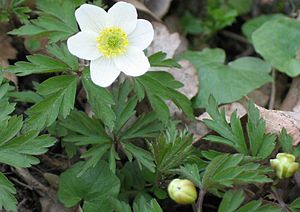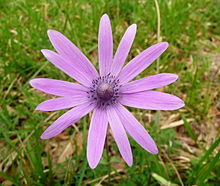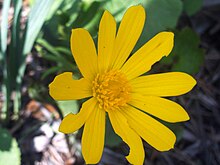Anemone
| Anemone | ||||||||||||
|---|---|---|---|---|---|---|---|---|---|---|---|---|

Wood anemone ( Anemone nemorosa ) |
||||||||||||
| Systematics | ||||||||||||
|
||||||||||||
| Scientific name | ||||||||||||
| anemone | ||||||||||||
| L. |
The Anemone ( Anemone ) constitute a genus within the family of Ranunculaceae (Ranunculaceae). This genus includes around 150 species that are native to the northern hemisphere and mainly in the temperate zones of Asia.
As an ornamental plant, many species have also found distribution in Central European gardens. The most important of these are the garden anemone ( Anemone coronaria ) and the Balkan anemone ( Anemone blanda ), also known as the ray anemone, from Turkey .
description












Vegetative characteristics
Anemone species grow as perennial, herbaceous plants , depending on the species they can reach very different heights (10 to 60 centimeters). There are rhizomes or tubers formed as Überdauerungsorgane.
The leaves are usually only basal; at the flowering time the basal leaves are missing in some species. The stalked basal leaves are simple or compound. The leaf blade can be lobed or divided. The leaf margins are smooth to toothed.
Generative characteristics
Depending on the species, there is a whorl (whorl) at different heights on the stem , usually two to seven (rarely up to nine) bracts or bracts similar to sepals . The terminal, zymous or umbellate inflorescences are rarely one, mostly two to nine flowered.
The hermaphroditic flowers are radial symmetry . The 4 to 20 (rarely up to 27) free bracts are 1.5 to 40 millimeters long. The colors of the bracts range from white to pink to red, from purple to blue, green and yellow. Nectaries are available. There are 10 to 200 stamens available. There are many free carpels, each containing only one ovule . A stylus is formed.
Many stalked or sessile, ovoid to obovate fruits ( follicles or nutlets) are formed per flower . The fruits are up to 40, rarely up to 50 millimeters long and sometimes hairy. The stylus is usually still clearly visible on the fruit.
Toxicity
All species are slightly poisonous when fresh due to protoanemonine , which is why arrow poison was extracted from them in the past. When drying and cooking, the poison contained is converted into the harmless anemonine . Anemones in fresh feed can cause poisoning in livestock.
Name declaration
The botanical name goes back to ancient times . Pliny the Elder connects it with the Greek anemos = wind. Anemona was also a nymph at the court of the goddess Flora . According to legend, Flora's husband Zephyr , the god of wind, fell in love with Anemona, whereupon she was transformed into a flower by the jealous goddess. However, it is more likely that the name anemone derives from an Arabic word for Adonis, namely an-nu'mān (= blood) and denotes a red-flowering plant.
Systematics and distribution
The generic name Anemone was first published by Carl von Linné .
The approximately 150 species are distributed worldwide on all continents except for Antarctica . The areas are mainly in the temperate zones . There are 53 species in China alone, 22 of which are endemic there . There are 25 species native to North America.
Types (selection)
The liverworts with the liverwort ( Anemone hepatica ) native to Europe used to be a separate genus ( Hepatica ), which included 6 species: Except Hepatica nobilis , Hepatica transsylvanica from Romania and four species from narrowly defined areas in East Asia, Hepatica falconeri , Hepatica henryi , Hepatica maxima and Hepatica yamatutai . According to the current taxonomic status, they are incorporated into the genus anemone .
- European species
- Altai Anemone ( Anemone altaica Fischer ex CAMeyer ) (Asia, Altai Mountains, but also occurs in Europe (Russia))
- Apennine anemone ( Anemone apennina L. )
- Tyrolean anemone ( Anemone baldensis L. )
- Balkan anemone, also known as ray anemone ( Anemone blanda Schott & Kotschy )
- Crown anemone , also garden anemone ( Anemone coronaria L. )
- Anemone dichotoma L. (East Asia, but also occurs in European Russia)
- Star anemone ( Anemone hortensis L. )
- Daffodil anemones or mountain cockerel ( Anemone narcissiflora L. )
- Windflower , popularly also called "witches Flower" ( Anemone nemorosa L. )
- Western Mediterranean anemone or palmate anemone ( Anemone palmata L. ) (Spain, Portugal, Sardinia, Sicily, Tunisia, Algeria, Morocco, formerly also in France)
- Anemone pavoniana Boiss. : This endemic occurs only in Spain in the Cantabrian Mountains .
- Peacock anemone ( Anemone pavonina Lam. ) (France, Central and Eastern Mediterranean)
- Yellow anemone ( Anemone ranunculoides L. )
- Backward curved anemone ( Anemone reflexa Stephan ) (East Asia, but also occurs in European Russia)
- Great Anemone ( Anemone sylvestris L. )
- Three-leaf anemone ( Anemone trifolia L. )
- Anemone uralensis fish. ex DC. (Ural, also occurs in the European part)
To:
- Hepatica ( Anemone hepatica L. , Syn .: Hepatica nobilis Schreber ) (Europe, East Asia, North America)
- Transylvanian liverwort ( Anemone transsilvanica (foot) Heuffel) (Syn .: Hepatica transsilvanica foot ), occurs in herbaceous deciduous forests in Romania in the Carpathian Mountains and in Transylvania up to 2000 m above sea level.
- Asian species:
- Baikal anemone ( Anemone baicalensis Turcz. & Ledeb. ) (Eastern Siberia, North Korea, China)
- Caucasus anemone ( Anemone caucasica Willd. Ex Rupr. ) (Caucasus, Asia Minor)
- Turkestan anemone ( Anemone eranthioides rule ) (Central Asia)
- Flaccid anemone ( Anemone flaccida F.Schmidt ) (Amur area, North China, Japan, Sakhalin)
- Leaved anemone ( Anemone glaucifolia Franch .; Is also placed as Anemoclema glaucifolium (Franch.) WTWang in its own genus Anemoclema ): It occurs in forests and grasslands at altitudes of 1700 to 3000 meters in the Chinese provinces of southwestern Sichuan and northwestern Yunnan.
- Autumn anemone ( Anemone hupehensis (E.Lémoine) E.Lémoine ) (Chinese province of Hupeh, Japan)
- Anemone leveillei Ulbr. (West China)
- Blunt-lobed anemone ( Anemone obtusiloba D.Don ), occurs in the Himalayas (Pakistan and Afghanistan to southeast Tibet, China, Myanmar)
- Multi-flowered anemone ( Anemone polyanthes D. Don ) (Eastern Himalayas and Pakistan)
- Pheasant anemone ( Anemone raddeana usually ) (Korea)
- Richardson anemone ( Anemone richardsonii Hook. ) (Arctic North America, Greenland, Kamchatka, Arctic Siberia)
- Anemone rivularis Buch.-Ham. ex DC. (Bhutan, Nepal, Sikkim, China, Sri Lanka, Sumatra)
- Rock anemone ( Anemone rupicola Cambess. ): It occurs in the Himalayas, in China (Tibet, Sichuan, Yunnan at altitudes of 2400 to 4200 meters).
- West Himalayan anemone ( Anemone tetrasepala Royle ), occurs in fir forests, on alpine meadows, on rocky stream banks in the West Himalayas (Afghanistan, Kashmir, Northwest India, Pakistan) at altitudes between 2100 and 3600 meters
- Felt-leaved anemone ( Anemone tomentosa (Maxim.) C.Pei ): It occurs in grasslands at altitudes of 700 to 3400 meters in the Chinese provinces of Hebei, Henan, Hubei, Qinghai, Shanxi and Sichuan
- Spoon-leaved anemone ( Anemone trullifolia Hook. F. & Thomson ), occurs in Bhutan, Nepal, Sikkim, Tibet, China at altitudes between 2500 and 4500 meters
- Vine-leaved anemone ( Anemone vitifolia Buch.-Ham. Ex DC. ): It occurs in light forests, in grass flats, on river banks at altitudes of 1200 to 2700 meters in Bhutan, Nepal, Sikkim, northern Myanmar, Sichuan, Yunnan and Tibet .
To:
- Hepatica henryi (Syn .: Anemone henryi Oliver ): It occurs in China.
- North American species:
- Canada wood anemone ( Anemone canadensis L. ) (Canada, USA, naturalized in Scandinavia)
- Carolina anemone ( Anemone caroliniana Walter ) (from Texas and Alabama to South Dakota and Minnesota)
- Prairie anemone ( Anemone cylindrica A. Gray ): It occurs in dry, open forests, on prairies, on pastures, on roadsides in North America at altitudes of 300 to 3000 meters.
- Drummond's anemone ( Anemone drummondii S. Watson ) (Alaska, Canada, USA)
- Pacific anemone ( Anemone multifida Poir. ) (Alaska, Canada, USA, temperate South America)
- Reef anemone ( Anemone riparia fernald ) (Canada, USA)
- Virginia anemone ( Anemone virginiana L. ) (Canada, USA)
- Other types:
- Cordillera anemone ( Anemone decapetala Ard. ) (South America)
- Mexican anemone ( Anemone mexicana Humb., Bonpl. & Kunth ) (Mexico)
- Hybrids:
- Anemone × fulgens (DC.) J. Gay ( Anemone hortensis × Anemone pavonina )
- Anemone × lesseri H.R. Wehrh. ( Anemone multifida × Anemone sylvestris )
- Anemone × lipsiensis Beck ( Anemone nemorosa × Anemone ranunculoides ; Syn .: Anemone × intermedia Winkl. Ex Pritz. , Anemone × seemenii E.G. Camus )
use
Many species of the anemone genus are used as ornamental plants in parks and gardens . For cultivation in gardens in temperate areas, apart from the beautiful flowering, it was crucial that these species are persistent, hardy and easy to multiply.
photos
White-flowered anemone species:
Yellow anemone ( Anemone ranunculoides ):
proof
- Werner Greuter, Hervé-Maurice Burdet, Guy Long (eds.): Med-Checklist. A critical inventory of vascular plants of the circum-Mediterranean countries . Vol. 4: Dicotyledones (Lauraceae - Rhamnaceae) . Conservatoire et Jardin Botanique, Genève 1989, ISBN 2-8277-0154-5 , pp. 393-395 (on- line ).
- Wang Wencai, Svetlana N. Ziman, Bryan E. Dutton: Anemone. In: Wu Zhengyi, Peter H. Raven, Deyuan Hong (Eds.): Flora of China . Volume 6: Caryophyllaceae through Lardizabalaceae . Science Press / Missouri Botanical Garden Press, Beijing / St. Louis 2001, ISBN 1-930723-05-9 , pp. 307 (English, online - PDF file ).
- Bryan E. Dutton, Carl S. Keener, Bruce A. Ford: Anemone. In: Flora of North America Editorial Committee (Ed.): Flora of North America North of Mexico . Volume 3: Magnoliophyta: Magnoliidae and Hamamelidae . Oxford University Press, New York / Oxford a. a. 1997, ISBN 0-19-511246-6 , pp. 139-141 (English, online ).
- Eckehart J. Jäger, Friedrich Ebel, Peter Hanelt, Gerd K. Müller (eds.): Excursion flora from Germany . Founded by Werner Rothmaler. tape 5 : Herbaceous ornamental and useful plants . Springer, Spektrum Akademischer Verlag, Berlin / Heidelberg 2008, ISBN 978-3-8274-0918-8 .
- Anemone on the Germplasm Resources Information Network (GRIN), USDA , ARS , National Genetic Resources Program. National Germplasm Resources Laboratory, Beltsville, Maryland.
Individual evidence
- ↑ Helmut Genaust: Etymological dictionary of botanical plant names. 3rd, completely revised and expanded edition. Nikol, Hamburg 2005, ISBN 3-937872-16-7 , pp. 62-63 (reprint from 1996).
- ^ Sara B. Hoot, Anton A. Reznicek, Jeffrey D. Palmer: Phylogenetic Relationships in Anemone (Ranunculaceae) Based on Morphology and Chloroplast DNA. In: Systematic Botany. Volume 19, No. 1, 1994, pp. 169-200, JSTOR 2419720 .
- ↑ Otto Schmeil , Jost Fitschen (greeting), Siegmund Seybold: Flora of Germany and neighboring countries. A book for identifying vascular plants that grow wild and often cultivated. 94th edition. Quelle & Meyer, Wiebelsheim 2006, ISBN 978-3-494-01468-5 .
- ↑ a b Jaakko Jalas, Juha Suominen (ed.): Atlas Florae Europaeae. Distribution of Vascular Plants in Europe. 8. Nymphaeaceae to Ranunculaceae. Akateeminen Kirjakauppa, The Committee for Mapping the Flora of Europe & Societas Biologica Fennica Vanamo, Helsinki 1989, ISBN 951-9108-07-6 , pp. 74-87.
- ↑ a b c d e f g h i j k l m n o p q r s t Walter Erhardt , Erich Götz, Nils Bödeker, Siegmund Seybold: The big zander. Encyclopedia of Plant Names. Volume 2. Types and varieties. Eugen Ulmer, Stuttgart (Hohenheim) 2008, ISBN 978-3-8001-5406-7 .
further reading
- N. Jiang, Z. Zhou, K.-Y. Guan, W.-B. Yu: Nomenclatural transfer of Chinese Pulsatilla to Anemone (Ranunculaceae). In: Nordic Journal of Botany , Volume 33, 2015, pp. 469–471. doi : 10.1111 / njb.00700
- SM Ziman, Y. Kadota, Olena V. Bulakh: Comparative-morphological approaches to the taxonomy of the genus Anemone L. (Ranunculaceae). In: Ukrainian Botanical Journal , Volume 70, April 2013. doi : 10.15407 / ukrbotj70.02.152
- Sara B. Hoot, Kyle M. Meyer, John C. Manning: Phylogeny and Reclassification of Anemone (Ranunculaceae), with an Emphasis on Austral Species. In: Systematic Botany , Volume 37, Issue 1, 2012, pp. 139–152. doi : 10.1600 / 036364412X616729
- Svetlana Ziman, Elena Bulakh, Olga Tsarenko: Anemone L. (Ranunculaceae): comparative morphology and taxonomy of the species from the Balkan flora. In: Botanica Serbica , Volume 35, Issue 2, 2011, pp. 87-97. Full text PDF.
- DC Hao, X. Gu, P. Xiao: Anemone medicinal plants: ethnopharmacology, phytochemistry and biology. In: Acta Pharmaceutica Sinica B , Volume 7, Issue 2, March 2017, pp. 146-158.




